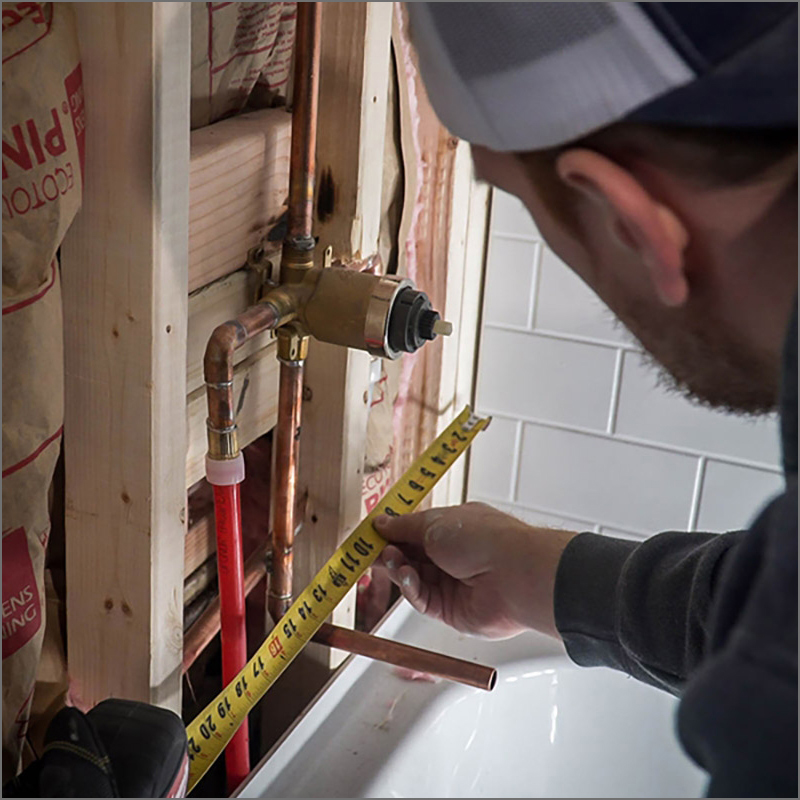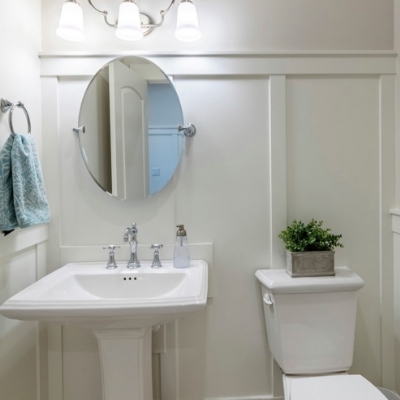Bathtub Buying Guide: Sizes & Types

Last updated April 4, 2025
Perfect for a relaxing soak, bathtubs are a welcome addition to most any bath. From traditional clawfoot to modern freestanding styles, the types of bathtubs available are almost endless. Use this guide to determine which one fits your space, style and budget. Learn everything from the best bathtub material to standard bathtub sizes.
Table of Contents
Standard Bathtub Sizes & Measurement Tips
Choosing the Perfect Bathtub Size
What to Consider When Buying a Bathtub
Alcove Bathtubs
Corner Bathtubs
Drop-In Bathtubs
Standard Bathtub Sizes & Measurement Tips

Understanding bathtub sizing is straightforward.
- The most common, standard bathtub is an alcove bath, measuring around 60 inches long, 30 inches wide and 14 to 16 inches high.
- Soaking tub dimensions measure between 60 to 72 inches long and have a depth of 14 inches or more.
- Oversized tubs are over 70 inches long and have a soaking depth of 16 inches or more.
Once you decide on your ideal tub, make sure it fits in your space. Using a measuring tape, find:
- Length
- Width
- Height
- Soaking depth
- Basin length
- Basin width
Tip: When replacing a bathtub, mark existing water connections and select an orientation that matches the layout of your bath.
Choosing the Perfect Bathtub Size

When considering a bathtub size, several factors can help with your final decision.
- Though you may have measured enough space for the tub itself, you still need to take into account how much space around the tub you’ll need for plumbing, tiling and other additions.
- If you want the tub to be situated away from the wall, you must make sure there’s enough room to walk around in the bathroom.
- The space in your bathroom includes making sure any non-standard-sized tub is far enough away from the toilet.
- For extremely large tubs, you may have to alter the size of your bathroom doorway to get it inside the room.
- Other custom work may be desired as well.
- You must also build according to your local code requirements, which may include getting a permit.
- The cost of any renovations may be a big factor in your decision, including the cost of hiring a professional plumber or bathtub installer.
The experience of bathing in a tub is often enhanced by more depth.
- Regular tubs may get up to 18 inches deep, allowing you to only have your legs under the water.
- Specialized freestanding and soaking tubs start at around 20 inches deep, but they can get as deep as 27 inches or even up to 34 inches. You can submerge most or all of your body.
How many gallons in a bathtub is ideal? Since people usually don’t fill their tubs to capacity, the number of gallons isn’t the best way to consider comfort. The overall depth is a better measurement because of how roomy it feels, and deeper tubs hold more water.
- Bathtubs can hold anywhere from 40 gallons on average to over 200 gallons for some luxury soaker tubs.
- Keep in mind that, with deeper tubs, you have to plan for accessibility.
- You also need to factor in the costs of materials that insulate and keep the water warm, remodeling materials to accommodate the larger size, and materials for proper plumbing.
What to Consider When Buying a Bathtub

Is your new bathtub for a guest bath or part of a primary suite? Is it for family use or a private retreat? How big is your water heater? When choosing a new bathtub, your answers will determine the model, size, features and material.
- Size: An oversized corner bath with combination whirlpool and air jets makes a great addition to a primary bath. A walk-in bathtub perfectly suits a first-story bath or guest bathroom.
- Space: When replacing an existing bathtub, match the size, shape and water connections of the prior tub.
- Structure: Water is heavy, so make sure the floor and supports are in good condition. If you’re working with a new space, make sure your plumbing connections and water heater are adequate.
- Durability: Budget-friendly fiberglass bathtubs aren’t as durable as a solid-surface bathtub. Long lasting copper or stone resin bathtubs require a high upfront investment.
- Style: Even tubs of the same type and material can have very different shapes and styles. Make sure to explore several options to find a bathtub design that fits your look and decor.
Tip: Safety is the most important factor to consider for any bathtub. Babies and toddlers are at risk of drowning in as little as 2 inches of water, while anyone older is at risk of falling. Research and take precautions to make your bathtub safer for the whole family.
Alcove Bathtubs

Alcove bathtubs are recessed into a wall and surrounded on three sides. They are the most common type of bathtub and are usually found in standard bathtub sizes. Alcove bathtubs offer a wide range of style options, shapes and finishes.
- Classic, compact design
- Ideal for smaller bathrooms
- Easily installed in tight spaces
- Budget-friendly
Corner Bathtubs

Corner bathtubs are designed to fit into a corner of a bathroom. They take up less space than traditional bathtubs. Though usually a triangular or wedge shape, alcove bathtubs come in several shapes and sizes.
- Comfortable, elegant and stylish
- Great for small bathrooms, apartments and condos
- Makes primary baths look even more spacious
- Some types have built-in storage options such as shelves or drawers
Drop-In Bathtubs

Drop-in tubs are installed into a pre-cut opening in the floor. These types of bathtubs are a popular choice for an elegant, modern bath look.
- Customizable and versatile
- Available in different shapes and sizes
- Easy to install into existing openings
- More size, shape and material options
- Easy to enter and exit
Freestanding Bathtubs

Freestanding bathtubs are not attached to the walls or floor. These bathtubs are designed to be the focal point of the room.
- Luxurious, elegant
- Oval, rectangular, round shapes
- Unique floor faucets
- Works well with different size spaces
Note: Freestanding tubs can be more dangerous than other types because there is nothing to hold when getting into or out of the tub.
Soaking Bathtubs

Clawfoot bathtubs and other types of soaking tubs are made for relaxation. They do not have any air or water jets. They are best for long soaks with bath oils or salts.
- Ergonomic contours for comfort
- Optional features such as heaters
- Available in popular bathtub types
- Wall-mounted faucets
Whirplool and Jetted Bathtubs

Relaxing and therapeutic, jetted bathtubs have jets that massage the body. Jetted or whirlpool tubs provide soothing hydrotherapy to relieve soreness and muscle tension.
- Comfortable, variable speeds
- Features can include heaters, LED lights and built-in speakers
- Molded armrests, lumbar support and other options
- Combination whirlpool/air bathtubs offer both air and water streams
Tub and Shower Combos

Tub and shower combos provide the convenience of a shower with the relaxation of a bathtub.
- Good for baths with limited square footage
- Come in a variety of styles and designs
- Can have walls on three sides or glass enclosure
- Perfect for families with young children
Walk-In Bathtubs

Safe and accessible, walk-in bathtubs allow for easy entry and exit. They also feature a low step, usually 3-4 inches high.
- Ideal for those with mobility issues
- Equipped with handrails and anti-slip surfaces
- Optional built-in seating options, therapeutic jets and heated surfaces
Types of Bathtub Materials

Bathtubs come in a variety of materials. Some of the most popular are:
- Acrylic bathtubs are made of acrylic vacuum-formed over molded fiberglass sheets. Budget-friendly, they are lightweight, easy to install and available in many shapes, styles and colors.
- Fiberglass bathtubs are made of molded fiberglass sheets with a top layer of gel coat. They are budget friendly and easily installed. However, the finish is prone to scratches and cracks.
- Porcelain-enameled bathtubs are made of an iron or steel tub with a thick layer of enamel in a glossy finish. They retain heat, are extremely durable and resistant to chips, scratches and dents.
- Solid surface bathtubs are made of a mineral and synthetic resins. With a seamless surface that’s non-porous and hygienic, they can require a higher upfront investment.
- Copper bathtubs develop a one-of-a-kind multicolored patina finish. Rust-proof, mildew-resistant and extremely durable, it can require a sizeable upfront investment.
- Stone resin bathtubs are made from a blend of resin and crushed natural stone for a unique look. They resist stains, mildew, scratches and cracks.
Acrylic vs. Fiberglass vs. Cast Iron Bathtubs

Acrylic, fiberglass and cast iron tubs each have their advantages. Deciding which is better for your bathroom will depend on your budget and how long you want your tub to last.
- Cast iron tubs require less maintenance and are a better long-term investment. Their weight requires extra floor support and installation by professionals.
- Acrylic tubs are budget friendly and last about 15 years.
- Fiberglass tubs are more durable than acrylic but are likely to crack, fade and chip.
Bathtubs come in a wide variety of models, materials, functions and styles. Each has its own unique features and characteristics. The best bathtub for your home depends on your space, desired features and budget. Ready to find your perfect bathtub? Use The Home Depot Mobile App to locate products and check inventory. We'll take you to the exact aisle and bay. Looking for help with your project? Our bathroom installation services will help you get the job done.




































